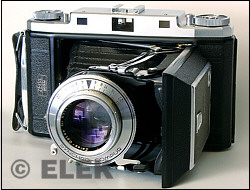Zeiss Ikon Mess Ikonta 524/2

|
|
|
| Style, film format | 6x9 120 roll film camera with uncoupled rangefinder |
|
|
|
| Lens, shutter | Coated f/3.5 105mm Tessar with Synchro-Compur shutter |
|
|
|
| Photo quality | Excellent |
|
|
|
| Ergonomics | Left-handed shutter release and remember that it's an uncoupled rangefinder. |
|
|
|
When it came to 6x9 cameras, you could do a lot worse than a Zeiss Ikon. In the 1950s, Zeiss Ikon modernized the look of its folding cameras, bringing in somewhat fresh designs that featured satin chrome top decks and the latest coated lenses.
The Mess Ikonta (so named because it uses an uncoupled rangefinder) is a sibling of the Contina II and the 524/16 (6x6) camera. The styling and operation of all three cameras was similar.
The 6x9 camera gives a big negative. At 6x9, you're not that far from exiting medium format and stepping into the world of large format. Well, I might be stretching things a bit, but a 6x9 negative is a big piece of celluloid.
The Ikonta 524/2 is simple to operate. Looking at the front of the camera, the top deck has two buttons. One on the left unlatches the lens bed. The button on the right is the shutter release.
Like its smaller siblings, the photographer still has to focus using the dial on the right (as you hold the camera to your eye) while peering through the small circular viewfinder. Read the distance from the dial and transfer that setting on the lens scale. Next, set your aperture and shutter speed. Tension the shutter and you're ready to frame your shot using the rectangular eyepiece.
Like many other Zeiss Ikon 6x9 cameras, I've found that the best method is a modified "hamburger" grip, using the index finger of your left hand to trip the shutter.
The Mess Ikonta folds flat, not as flat as some similar cameras but flat enough to slip into a camera bag or large jacket pocket without any problems.
The Mess Ikonta, like nearly all of the postwar folding cameras, was offered with either a coated Novar or coated Carl Zeiss Tessar. Note that some very early postwar cameras used uncoated prewar lenses, uncoated postwar lenses or a Schneider-Kreuznach Xenar. The Mess Ikonta was introduced later and had only the Novar or Tessar as the available lenses with the Tessar being the premium lens.
In any case, the Mess Ikonta is an excellent camera and represents some of the best of postwar camera design and manufacturing.
